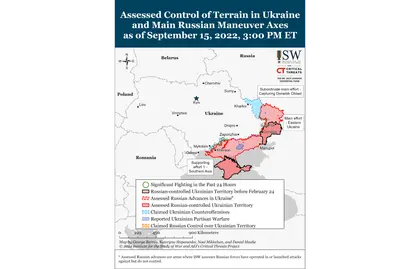Key Takeaways
- Ukrainian forces continued counteroffensive operations in eastern Ukraine.
- The Kremlin is responding to the defeat around Kharkiv Oblast by doubling down on crypto-mobilization, rather than setting conditions for general mobilization.
- The Kremlin has almost certainly drained a large proportion of the forces originally at Russian bases in former Soviet states since Russia’s full-scale invasion of Ukraine began in February, likely weakening Russian influence in those states.
- Russian and Ukrainian sources reported Ukrainian ground attacks northwest of Kharkiv City, near the Ukrainian bridgehead over the Inhulets River, and south of the Kherson-Dnipropetrovsk Oblast border.
- Russian-appointed occupation officials and milbloggers claimed that Ukrainian forces conducted a landing at the Kinsburn Spit (a narrow peninsula of the Crimean Peninsula).
- Russian forces conducted limited ground assaults and are reinforcing positions on the Eastern Axis.
- The Russian proxy Donetsk People’s Republic (DNR) is likely attempting to stop its administrators from fleeing ahead of the Ukrainian counteroffensive, demonstrating the bureaucratic fragility of the DNR
Ukrainian forces are continuing counteroffensive operations in eastern Ukraine, increasingly pressuring Russian positions and logistics lines in eastern Kharkiv, northern Luhansk, and eastern Donetsk oblasts. Russian sources reported that Ukrainian forces are continuing ground operations southwest of Izyum, near Lyman, and on the east bank of the Oskil River, reportedly compelling Russian forces to withdraw from some areas in eastern Ukraine and reinforce others.[1] Russian forces in eastern Ukraine will likely struggle to hold their defensive lines if Ukrainian forces continue to push farther east.
JOIN US ON TELEGRAM
Follow our coverage of the war on the @Kyivpost_official.
The Kremlin is responding to the defeat around Kharkiv Oblast by doubling down on crypto-mobilization rather than setting conditions for general mobilization. Chechen leader Ramzan Kadyrov called on all federal subjects to initiate “self-mobilization” and not wait on the Kremlin to declare martial law.[2] Kadyrov claimed that each federal subject must prove its readiness to help Russia by recruiting at least 1,000 servicemen instead of delivering speeches and conducting fruitless public events. Russian propagandist Margarita Simonyan echoed the need for Russians to volunteer to join the war effort, and several loyalist Russian governors publicly supported Kadyrov’s speech.[3] The Russian-appointed head of occupied Crimea, Sergey Aksyonov, announced the formation of two volunteer battalions on the peninsula in support of Kadyrov’s calls.[4]

Russian Citizens Launch Campaign to Find Loved Ones Behind Front Lines
The defeat around Kharkiv Oblast prompted the Kremlin to announce a Russia-wide recruitment campaign. Kremlin officials and state media had not previously made country-wide recruitment calls but had instead tasked local officials and outlets to generate forces ostensibly on their own initiative. Kremlin Spokesperson Dmitry Peskov vaguely welcomed the creation of the battalions on July 12, while 47 loyalist federal subjects advertised and funded the regional volunteer battalion recruitment campaign.[5] A prominent Russian milblogger and a supporter of general mobilization praised officials such as Kadyrov for taking the recruitment campaign from the ineffective Russian Ministry of Defense; this recruitment revamp is likely to secure more support for the Kremlin among nationalist figures who are increasingly critical of the Russian MoD, even if the drive does not generate large numbers of combat-effective troops.[6]
The Kremlin has likely abandoned its efforts to shield select federal subjects from recruitment drives, which may increase social tensions. ISW has previously reported that the Kremlin attempted to shield Moscow City residents from reports of the formation of the Moscow-based “Sobyaninsky Polk” volunteer regiment.[7] Russian opposition outlet The Insider noted that several groups in the republics of Buryatia, Kalmykia, Tyva, and Yakytia (Republic of Sakha) are publicly opposed to the Kremlin’s emphasis on recruitment on an ethnic basis.[8] Simonyan’s statement about “self-mobilization” prompted numerous negative comments among Russians calling on Russian oligarchs to pay for and fight in the war.[9]
The Kremlin has almost certainly drained a large proportion of the forces originally stationed in Russian bases in former Soviet states since Russia’s full-scale invasion of Ukraine began in February, likely weakening Russian influence in those states. A Radio Free Europe / Radio Liberty (RFE/RL) investigation reported on September 14 that the Russian military has already deployed approximately 1500 Russian personnel from Russia’s 201st Military Base in Dushanbe, Tajikistan, to Ukraine since the full-scale invasion began and plans to deploy 600 more personnel from facilities in Dushanbe and Bokhatar, a southern Tajik city, in the future.[10] RFE/RL additionally reported on September 13 that Russia has likely redeployed approximately 300 Tuvan troops from the Russian Kant Air Base in Kyrgyzstan to fight in Ukraine at varying points since late 2021.[11]
The withdrawals from the Central Asian states are noteworthy in the context of border clashes between Kyrgyzstan and Tajikistan. Tajik and Kyrgyz border guards exchanged fire in three separate incidents on September 14, killing at least two people.[12] The uptick in violence between Tajikistan and Kyrgyzstan, both of which are members of the Russian-controlled Collective Security Treaty Organization (CSTO), comes alongside renewed aggression by Azerbaijan against CSTO member state Armenia. Russian forces also withdrew 800 personnel from Armenia early in the war to replenish losses in Ukraine, as ISW has previously reported.[13]
Authors: Kateryna Stepanenko, Katherine Lawlor, Grace Mappes, George Barros, and Frederick W. Kagan
See the full report here.
You can also highlight the text and press Ctrl + Enter










